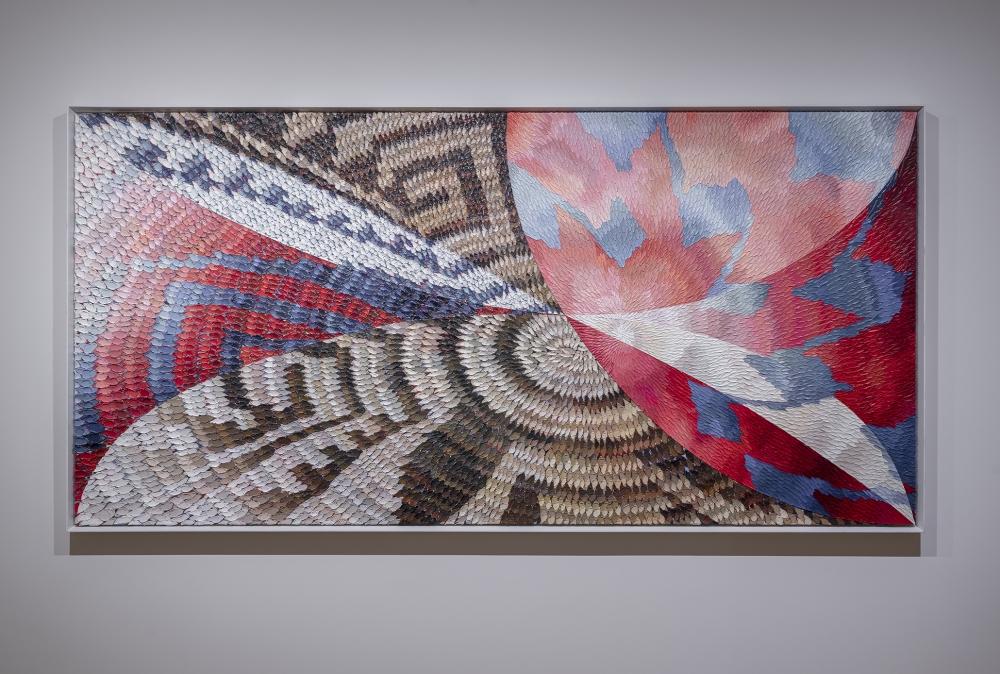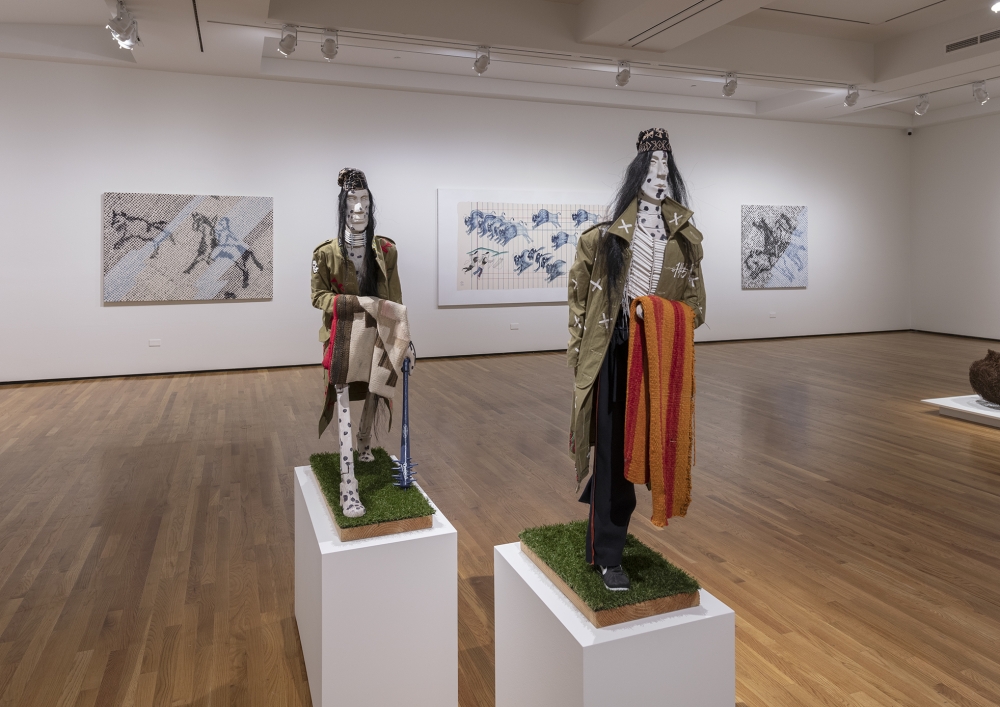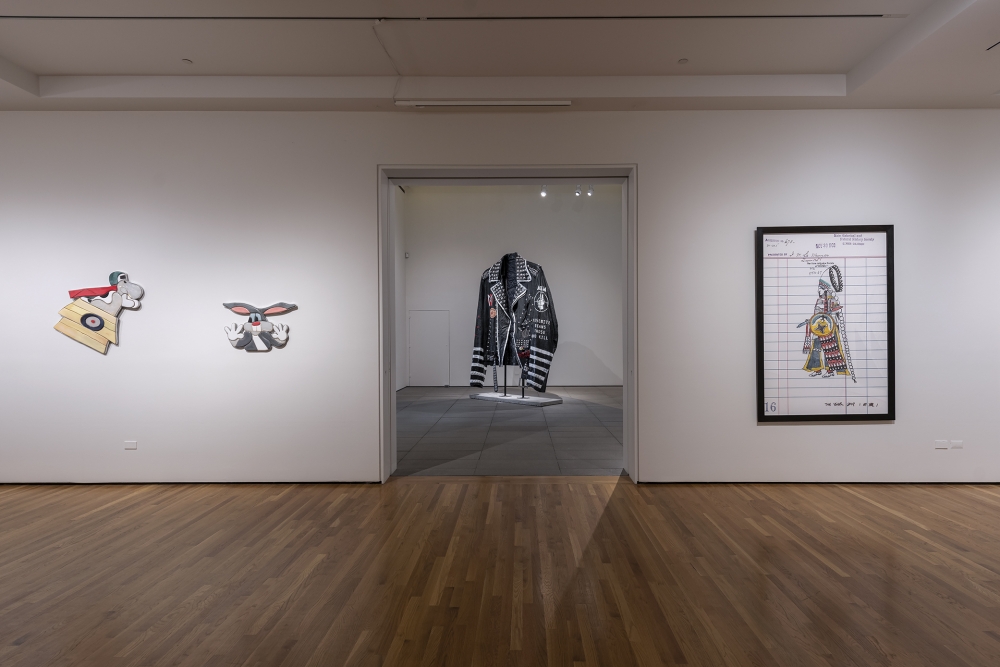Contemporary Art, Historical Resonance
A year and a half ago, Gabriel Ritter visited the Chris Sharp Gallery in Los Angeles hoping to discover some compelling new art. He was not expecting to be gobsmacked by a garment.
“This jacket stopped me in my tracks,” he recalled. “It’s almost a story tall. It looks like a punk jacket, or a biker jacket made for a giant.”
Once he started examining it, he realized there was a lot more to the work than its size.
It was festooned with patches covered in letters and symbols — a mash-up of images that evoked past and present, the personal and the political, ancient traditions and contemporary pop culture.
“That really caught my attention,” he recalled. Not only was it aesthetically stunning, but it was also a fractured portrait of Native American life and art, in all its complex multiplicity. “It is,” he concluded, “a monument to survival.”
Ritter was in Southern California from Minnesota to interview for the position of director of the Art Design & Architecture Museum (AD&A) at UC Santa Barbara. When he took over the job in September, he looked at the exhibition calendar and spotted an opening for one year later. He decided that would be the perfect time for his first show at the AD&A as a curator — a survey of art by the creator of the colossal jacket, Los Angeles based artist Ishi Glinsky.
The exhibition, “Ishi Glinsky: Upon a Jagged Maze,” is open now through Jan. 22, 2023. Its centerpiece is, of course, “Coral vs. King Snake Jacket,” the larger-than-life replica of a leather bomber jacket that first stunned Ritter. The piece, now part of the permanent collection at UCLA’s Hammer Museum, is one of 25 works by Glinsky included in the AD&A show.
Glinsky, 40, was born in Tucson, Arizona, to a mother of German descent and a father who is a member of the Tohono O’odham Nation. He embraced his Native American heritage from an early age, dancing at traditional Powwows as a teen and making his own regalia to do so.
“For the past 16 years, he has been living and working in Los Angeles, but he has not had a solo museum exhibition in that time,” Ritter said. “Since I see creating a regional dialogue for contemporary art as one of my jobs here, this seemed like a great opportunity — and very much on brand for the vision I want to chart for this institution.”
Ritter, who is also an associate professor in UC Santa Barbara’s History of Art & Architecture department, describes Glinsky as “a Native American artist with one foot in contemporary art, and the other foot in the traditions of multiple Indigenous nations.” Like his cultural ancestors, he uses everyday items in his work — Ritter jokes that he uses Home Depot as a sort of art-supply store — as well as found objects and refuse ranging from skateboard wheels to skeleton keys.
“His work is comparable to Claes Oldenburg, in that he plays with scale,” Ritter said. “In Ishi’s case, this is to bring attention to these traditions and art-making practices that have largely been overlooked. He literally creates larger-than-life pieces, so people can’t help but take notice of them and pay attention.”
“The works shown here are an inter-tribal celebration of heritage,” Glinsky said, adding that he hopes to either introduce viewers to, or expand their knowledge of, Indigenous movements, history and artistic traditions, including crafts.
One such movement is “ledger art,” which Glinsky engages in several pieces in the show. This art form emerged in 19th-century accounting ledgers, “books that were traded between settlers and Native Americans of the Plains states,” Ritter said. “They became the repositories of a new visual storytelling language. Hopefully, the works start a conversation around this art form and its history.”
Since this is Glinsky’s first museum show, Ritter had no road map as to how to present his art, and he and the artist had numerous conversations before settling on an early-career retrospective survey.
“There is a series of paintings, sculptural works, works on paper and a series of necklaces,” Ritter said. “They are, again, scaled up enormously.”
“Looking at the past, or in the mirror, is a bit of a trip,” said Glinsky. “Viewing this work at UCSB has allowed me to actively pause and trace my own footsteps. What is seen, and on view, is in my DNA.”
After assembling the show, Ritter faced another challenge: creating descriptive labels that would put the works in context. He enlisted the help of Kendall Lovely, a Ph.D. student in history at UC Santa Barbara whose research centers on Indigenous history and material culture in the U.S. Together, they strove to “guide a general audience through these works” by describing both Glinsky’s artistic techniques and the historical traditions he draws from.
For example, some of the necklaces in the show reference pieces from the Santo Domingo tribe in New Mexico — “necklaces that are called ‘battery birds,’ because they were originally made using pieces of plastic taken from car batteries,” Ritter said. “Ishi’s use of found materials is an echo of these prior practices. It’s kind of a form of homage while also being a part of his current practice.”
But not every reference is historical: There are also nods to the rap group Public Enemy and such current-day political organizations as the American Indian Movement. “What I find so interesting about Ishi’s work is that it refuses to be just one thing,” Ritter said. “It asks the viewer to consider the multiplicity of its meaning.”
That said, Glinsky’s work can also be appreciated on a more basic level: It is pleasing to the eye. “These works are meticulously and beautifully crafted,” Ritter said. “But they’re also imbued with great meaning and significance. They tell stories about traditions that have been left out of the contemporary art conversation and deserve to be recognized.”
----
“Ishi Glinsky: Upon a Jagged Maze” is on view through Jan. 22, 2023 at the AD&A Museum on the UC Santa Barbara campus. Hours are noon to 5 p.m. Wednesday through Sunday. Admission is free. For more information, visit www.museum.ucsb.edu or call 805-893-2951.







